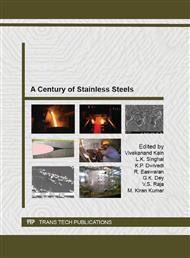p.201
p.214
p.222
p.230
p.238
p.248
p.257
p.274
p.289
Surface Engineering of Stainless Steels: Role of Surface Mechanical Attrition Treatment (SMAT)
Abstract:
Surface mechanical attrition treatment (SMAT) technique has became popular to develop a nanostructured surface layer on metallic materials for upgrading their overall properties and performance. In this paper, we have presented the SMATing behavior of low stacking fault energy material like AISI 304 using optical microscopy, SEM, microhardness measurement and XRD analysis. SMATing was performed for 15, 30, 45, 60, 75, 90 min by using hardened bearing-steel balls (size: 5.7 mm diameter, hardness: 500HV0.1) at 50 Hz vibrating frequency. XRD analysis indicated the lowest grain-size of about 8.6 nm in the surface region of specimen SMATed for 60 min. In comparison with the non-SMATed specimen, 17 times increase in the dislocation density and 4 times increase in the micro-strain were observed in this SMATed specimen. Improvement in the surface-hardness due to the SMAT was almost two times hardness before SMAT was 190 HV0.1 and after SMAT it was 400 HV0.1. There is a gradual decrease in the hardness value across the cross-section of the specimen, and core-hardness value was reached after 300 μm depth below the surface. XRD results indicated the possibility of martensitic phase transformation at the surface during SMATing of AISI 304 steel. SMATed AISI 304 specimens showed good thermal stability at 550°C for 6 h which was confirmed by microhardness measurement
Info:
Periodical:
Pages:
238-247
Citation:
Online since:
September 2013
Price:
Сopyright:
© 2013 Trans Tech Publications Ltd. All Rights Reserved
Share:
Citation:


